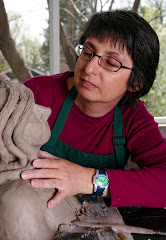This just in from Jennifer Hoolihan at Highwater Clay, in Asheville, NC. Jennifer and Les have helped me many times when I've had questions and needed advice on clay and glazes as has another great friend in the area, Paul.
Here is the article:
Ceramic Stain Act One by Jennifer Hoolihan |
On your visits to Highwater Clays, you might have noticed all the brightly colored bags of powder neatly lined up in the stain aisle. Perhaps you were beguiled by the visual display but wondered, what are these? Good question! Read on, and we will provide a little clarity on the wide world of ceramic stains in part one of our tech tip stain series.
Ceramic stains, like the brand Mason Color, offer a rainbow of color for the modern clay artist. What exactly are stains? Simply put, they are manufactured colorants. Stains are compounds made up of different oxides and minerals. Metal oxides such as iron, cobalt and copper are blended with elements like zirconium, zinc and tin. These auxiliary ingredients are used to stabilize and widen the color range of the metal colorants. Each stain has its own unique recipe. Once the raw materials are blended, the stains are heated to facilitate the chemical reactions needed to produce and stabilize the desired color. Some stains need to reach a high enough temperature to fuse, others just need a good cooking. When the heating process is complete, the stains are ground into a fine powder of about 200 mesh and washed to remove any remaining soluble material.
The point of this extensive procedure is to make a colorant that is consistent in hue and also stable across a wide temperature range. Colors and subtle shades that are difficult to achieve using raw oxides are provided for with stains. A stain doesn't really incorporate into a glaze melt the way a raw oxide does. In a stain, the stabilizers act to protect the coloring metals from being sucked into the wild molten glass of a melting glaze. The colorant remains suspended as a tiny particle in the melted glaze. A raw oxide, on the other hand, hooks up with other elements as a glaze gets molten. These other elements, such as titanium, tin and boron and the atmosphere of the firing can have a profound affect on the color development of raw oxides.
Often times the powder form of a stain is very similar to the fired color, thus taking a lot of guess work out of surface decoration and glazing. However, this is not to say a stain isn't affected by the chemistry of a base glaze. Different stains are more stable than others. This is where knowledge of specific stain colors comes in very handy. Fortunately, the Mason stain reference chart supplies all kinds of useful information. Mason, and other stain manufactures, won't tell you the exact recipe of a stain but they will tell you the components, like if it contains cobalt, nickel, etc. Those random little numbers listed under the color sample give valuable clues on how to use each stain to its fullest potential and avoid unhappy glaze results. It lists how much stain and opacifier is needed to replicate the color shown in the chart. This is really useful since some stains are stronger and more opaque than others. It gets really juicy when you start reading the reference numbers for each stain. You find out which stains don't play well with zinc (most greens) and why your pink glaze fired out splotchy gray (not enough calcium in the base recipe). And why are there 6 different black stains? It's all in the reference chart. You still want to test, test and test, but the reference chart gets you off to a good start.
Now that we have covered the 'what' of ceramic stains, part two of our series will delve deeper into different ways of using stains. We'll learn various ways of incorporating them into your work with recipes and useful tips. We'll also get a bit more technical to increase our understanding of the ins and outs of the Mason reference chart. Until then, happy potting. |







No comments:
Post a Comment